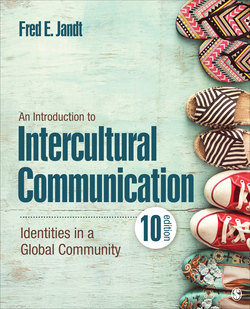Читать книгу An Introduction to Intercultural Communication - Fred E. Jandt - Страница 28
На сайте Литреса книга снята с продажи.
American Indians
ОглавлениеThe Census Bureau uses the term American Indian. That term is derived from a colonizer’s worldview—that is, Columbus thought he was going to India—and the land was named for another Italian navigator. It is a label applied to people by someone other than themselves. During the civil rights movements of the 1960s and 1970s, the term Native American came into common use as it was considered to represent historical facts more accurately (“native” predated European colonization). Yet that term as well is a label applied by outsiders and for some has the pejorative meaning from the colonial era of “primitive.”
To use the labels that people apply to themselves would be to use labels such as Cherokee, Seminole, and Navajo. However, in many cases, these labels are actually derived from names created by the groups’ neighbors or enemies. Mohawk is a Narragansett name meaning “flesh eaters.” Sioux is a French corruption of an Anishinabe word for “enemy.” Navajo is from the Spanish version of a Tewa word. A survey reported in 1997 showed that 96% of high school and college youth with American Indian or Native American heritage identified themselves with the nation name (e.g., Cherokee, Seminole).
In Canada, the term Indian is generally considered offensive. The term First Nations is now the preferred term. At the United Nations, the term indigenous peoples was first used in documents in 2002. Objections to this term include that it puts all peoples under one label.
In a 1977 resolution, the National Congress of American Indians and the National Tribal Chairmen’s Association stated that in the absence of a specific tribal designation, the preferred term is American Indian and/or Alaska Native. In a 1995 survey, 50% preferred the term American Indian to 37% for Native American. Some activists such as Russell Means publicly are said to prefer American Indian to Native American (“People Labels,” 1995, p. 28). In the belief that people should be referred to by the term they prefer, this text uses the label of specific nations or, when referring to all nations within the United States, the term American Indian.
Can one nation have two legal systems? Can two legal systems coexist equally? Some 573 distinct nations exist by treaty within the territorial limits of the United States. One is the federal government in Washington, D.C. The remaining 572 are American Indian nations recognized by the U.S. Bureau of Indian Affairs that enjoy some areas of complete sovereignty and some areas of limited sovereignty. By treaty, the American Indian nations have their own territory, governmental structure, and laws; collect their own taxes; and are protected by U.S. federal law in the practice of their culture and religion (Dudley & Agard, 1993). The American Indian Religious Freedom Act of 1978 proclaimed “to protect and preserve for American Indians their inherent right to believe, express and exercise the traditional religions.”
Tribal sovereignty refers to the ability of tribes to govern themselves (Pevar, 2012). The U.S. Constitution gives Congress rather than the states exclusive authority over American Indian affairs. The 1832 Supreme Court decision in Worcester v. Georgia ruled that the state could not impose its laws on a Cherokee Indian reservation. In modern times, it is the issue of gaming that has further defined the relationship between tribes and the state and federal governments. A 1987 Supreme Court decision in California v. Cabazon Band of Mission Indians ruled that the state has no authority to regulate tribal gaming if the state otherwise allows any form of gaming. The following year, Congress adopted the Indian Gaming Regulatory Act, which requires states to negotiate gaming compacts with tribes who wish to establish gaming operations. The states and tribes are to negotiate as distinct sovereigns, thus acknowledging shared sovereignty while retaining the authority to legislate all matters for the tribes including the form of government (United States v. Wheeler, 1978).
